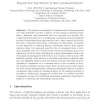Free Online Productivity Tools
i2Speak
i2Symbol
i2OCR
iTex2Img
iWeb2Print
iWeb2Shot
i2Type
iPdf2Split
iPdf2Merge
i2Bopomofo
i2Arabic
i2Style
i2Image
i2PDF
iLatex2Rtf
Sci2ools
ISBRA
2010
Springer
2010
Springer
A Consensus Tree Approach for Reconstructing Human Evolutionary History and Detecting Population Substructure
The random accumulation of variations in the human genome over time implicitly encodes a history of how human populations have arisen, dispersed, and intermixed since we emerged as a species. Reconstructing that history is a challenging computational and statistical problem but has important applications both to basic research and to the discovery of genotype-phenotype correlations. In this study, we present a novel approach to inferring human evolutionary history from genetic variation data. Our approach uses the idea of consensus trees, a technique generally used to reconcile species trees from divergent gene trees, adapting it to the problem of finding the robust relationships within a set of intraspecies phylogenies derived from local regions of the genome. We assess the quality of the method on two large-scale genetic variation data sets: the HapMap Phase II and the Human Genome Diversity Project. Qualitative comparison to a consensus model of the evolution of modern human popula...
| Added | 28 Jan 2011 |
| Updated | 28 Jan 2011 |
| Type | Journal |
| Year | 2010 |
| Where | ISBRA |
| Authors | Ming-Chi Tsai, Guy E. Blelloch, R. Ravi, Russell Schwartz |
Comments (0)

